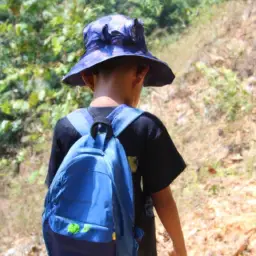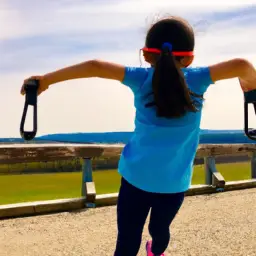Do you want your child to be able to overcome failure and challenges with grit and resilience? It’s a common desire for parents to want their children to be able to bounce back from setbacks and keep pushing forward.
Developing these qualities in children can lead to a growth mindset that sets them up for success in all areas of their life.
Understanding the importance of grit and resilience in children is the first step. These qualities allow children to persevere through difficult situations, learn from their mistakes, and grow stronger from their experiences.
Building these traits takes time and effort, but with practical strategies and a growth mindset, your child can learn to overcome obstacles and thrive in the face of adversity.
Let’s dive into how you can foster grit and resilience in your child to help them reach their full potential.
Key Takeaways
- Parents can model grit and resilience by showing that setbacks are natural and encouraging children to keep trying.
- Activities such as playing challenging games and outdoor experiences can help build resilience and a growth mindset in children.
- Encouraging risk-taking and exploration can lead to learning and discovering passions.
- Developing a growth mindset and resilience can foster independence, confidence, and the ability to overcome obstacles with determination and learn from mistakes.
Understanding the Importance of Grit and Resilience in Children
You can’t underestimate the importance of grit and resilience in your children – it’s what’ll help them bounce back from failure and develop a growth mindset. As a parent, it’s important to model these traits for your children, showing them that setbacks are a natural part of life. It’s important to keep trying even when things get tough.
By demonstrating perseverance and a positive attitude, you can help your children develop the same qualities in themselves. Another way to build resilience in your children is through play. Encouraging your children to engage in challenging activities, such as building a tower out of blocks or completing a difficult puzzle, can help them learn how to overcome obstacles and stay motivated even when things don’t go according to plan.
Additionally, playing with others can help children learn valuable social skills, such as communication and problem-solving, which can also contribute to their overall resilience. By prioritizing grit and resilience in your parenting approach, you can help your children develop the tools they need to overcome failure and thrive in all areas of life.
Fostering Grit and Resilience in Children
If you want to foster grit and resilience in your children, you need to provide them with opportunities for growth and learning. Encourage them to take risks and explore new things, even if it means they might fail.
Teach them coping strategies for stress and anxiety so they can handle challenges with confidence and resilience. By doing these things, you can help your children develop the skills they need to overcome obstacles and thrive in life.
Providing Opportunities for Growth and Learning
By providing opportunities for growth and learning, you’ll be able to help your child develop resilience and a growth mindset. Here are some ways to do this:
-
Encourage outdoor activities: Spending time in nature has been shown to improve children’s mental and emotional well-being. It also provides opportunities for exploration and discovery, which can help build resilience and a sense of adventure.
-
Provide hands-on experiences: Children learn best by doing. Hands-on experiences allow them to try new things, make mistakes, and learn from them. This can help build confidence and a growth mindset.
-
Foster a love of learning: Encourage your child to explore their interests and pursue their passions. Provide resources and support for them to learn and grow in their areas of interest. This can help build a love of learning and a sense of purpose.
By providing opportunities for growth and learning, you’ll be giving your child the tools they need to face challenges and overcome obstacles. These experiences can help them build resilience, a growth mindset, and a sense of curiosity and wonder.
Encouraging Risk-Taking and Exploration
Encouraging risk-taking and exploration can lead to exciting opportunities for children to learn and discover their passions. When children are encouraged to take risks, they become more confident in their abilities and are willing to try new things. This can lead to them discovering new interests and talents that they may have otherwise never explored.
It’s important to encourage curiosity in children, as it helps them develop a love for learning and a desire to explore the world around them. By promoting creativity, children can also learn to think outside the box and come up with innovative solutions to problems they may face.
However, it’s important to note that encouraging risk-taking and exploration should be done in a safe and controlled environment. Children should be taught to assess the risks and consequences of their actions before taking any major risks.
Parents and educators can guide children as they explore and take risks, providing them with support and encouragement along the way. By promoting a growth mindset and instilling a sense of resilience in children, they can learn to overcome failure and setbacks, further developing their grit and determination to succeed.
Teaching Coping Strategies for Stress and Anxiety
Teaching coping strategies for stress and anxiety can help kids manage overwhelming emotions and feel more in control of their thoughts and feelings. Coping techniques can range from deep breathing exercises and meditation to journaling and physical exercise.
It’s important to teach children that feeling stressed or anxious is normal, but it’s how they respond to these feelings that really matters. One effective stress management technique is teaching kids to reframe their thoughts. Instead of catastrophizing or assuming the worst, encourage them to think about the situation in a more positive light. This can help them feel more empowered and less overwhelmed.
Additionally, reminding children that failure and mistakes are a natural part of the learning process can help them develop a growth mindset and bounce back from setbacks with more resilience. By teaching coping strategies, you can help children develop the skills they need to manage stress and anxiety in a healthy way.
Developing a Growth Mindset
You can help your child develop a growth mindset by emphasizing the power of effort and practice. Encourage them to understand that success isn’t just about innate abilities, but also about dedication and hard work.
Teach them to embrace failure as a learning opportunity, and encourage a love of learning by showing them that mistakes are a natural part of the process.
Emphasizing the Power of Effort and Practice
By acknowledging the power of effort and practice, you can help your child develop a growth mindset that can help them overcome failure and achieve success. Teaching them to work hard and practice regularly can give them the tools they need to persevere through challenges and setbacks. Encouraging them to take risks and learn from mistakes can also help them develop a sense of resilience and determination that will serve them well throughout their lives.
To help your child fully embrace the power of effort and practice, consider the following tips:
-
Praise effort over natural ability: Instead of telling your child how smart or talented they are, focus on praising their hard work and persistence. This can help them see the value of putting in effort and motivate them to keep trying even when things get tough.
-
Provide opportunities for practice: Whether it’s practicing a musical instrument, playing a sport, or learning a new skill, regular practice is essential for growth and improvement. Encourage your child to practice regularly and offer opportunities for them to do so.
-
Set achievable goals: Setting goals that are challenging but achievable can help your child develop a sense of accomplishment and build confidence in their abilities. Help them break down larger goals into smaller steps and celebrate their progress along the way.
-
Encourage risk-taking: Encourage your child to take risks and try new things, even if they might fail. Emphasize that failure is a natural part of the learning process and help them see it as an opportunity to learn and grow.
-
Model a growth mindset: Children learn by example, so make sure you’re modeling a growth mindset in your own life. Show them that you’re willing to take risks, learn from mistakes, and put in effort to achieve your goals.
Encouraging a Love of Learning
Immerse yourself in the joy of learning alongside your child by exploring new topics and discovering new passions together. Building curiosity and cultivating creativity are key in encouraging a love of learning. By asking questions, listening to your child’s ideas, and supporting their interests, you can help them develop a deep curiosity and desire to learn more about the world around them.
One way to build curiosity and creativity is to provide your child with opportunities to explore different subjects and activities. Encourage them to try new things, whether it’s learning a new skill, trying a new hobby, or reading about a new topic. Use the table below to brainstorm ideas for activities that can spark your child’s curiosity and creativity. Remember, the goal is not just to learn, but to have fun and enjoy the process of discovery. With your support and encouragement, your child can develop a lifelong love of learning.
| Subject/Activity | How to Explore | |||
|---|---|---|---|---|
| Science | Conduct experiments, visit a science museum, watch documentaries | |||
| Art | Take an art class, visit an art museum, experiment with different mediums | |||
| History | Visit historical sites, read historical fiction, watch historical documentaries | |||
| Music | Take music lessons, attend concerts, learn to play an instrument | |||
| Nature | Go on nature walks, visit a botanical garden, learn about different animals and plants | Sports | Join a sports team, attend sporting events, learn a new sport |
Teaching Children to Embrace Failure as a Learning Opportunity
Take a moment to reflect on how mistakes can be valuable opportunities for learning and growth. It’s important to teach children to embrace failure as a learning opportunity instead of fearing it. Encouraging a positive mindset towards setbacks can help children develop grit and resilience.
To help children embrace failure, you can:
-
Normalize mistakes by sharing your own experiences of failure and how you learned from them.
-
Focus on effort rather than just the outcome. Praise your child for trying their best, even if they don’t succeed.
-
Help your child reframe their perception of failure by asking them what they learned from their mistakes and how they can improve next time.
By teaching children to embrace failure as a learning opportunity, you’re helping them develop a growth mindset. This positive mindset can help them overcome obstacles and challenges in the future with resilience and determination.
Practical Strategies for Building Grit and Resilience
You can develop grit and resilience in your children by incorporating small challenges and obstacles into their daily routine. This will help them learn how to overcome failure and develop a growth mindset.
As a parent, you can start by fostering grit and resilience in your child by encouraging them to try new things, take risks, and embrace failure as a learning opportunity.
Practical tips for building resilience include setting achievable goals, breaking tasks into manageable steps, and providing positive feedback and encouragement. You can also help your child build resilience by teaching them coping strategies, such as deep breathing or mindfulness techniques.
By incorporating these strategies into your child’s daily routine, you can help them develop the necessary skills to overcome challenges and setbacks, and ultimately build a resilient and growth-oriented mindset.
Overcoming Obstacles and Challenges
So you want to help your children overcome obstacles and challenges? One way to do this is by teaching them problem-solving skills. Encourage them to think critically and find solutions to their problems, rather than giving up too easily.
Another important aspect is perseverance and determination, which can be fostered by providing support and encouragement along the way. Remember, with your guidance, your children can learn to overcome challenges and become more resilient.
Teaching Children to Problem-Solve
Let’s work on teaching your child problem-solving skills by encouraging them to think creatively and come up with multiple solutions to a problem. This will not only help them overcome obstacles but also foster independence and confidence in their abilities.
Start by presenting your child with a problem or challenge and ask them what they think the best solution could be. Allow them to brainstorm and come up with multiple ideas, even if some of them may seem unrealistic or silly.
Once your child has come up with several potential solutions, help them evaluate each one by discussing the pros and cons of each idea. This will help them learn how to weigh their options and make informed decisions. Encourage your child to not give up if their first idea doesn’t work out, and to keep trying until they find a solution that works.
By teaching your child problem-solving techniques, you’re helping them develop important life skills that will serve them well in the future.
Teaching your child to problem-solve is an essential skill that will help them overcome obstacles, foster independence, and develop confidence in their abilities. By encouraging them to think creatively and come up with multiple solutions, you’re helping them develop critical thinking skills that will serve them well throughout their lives.
Remember to support your child as they navigate challenges and obstacles, and help them evaluate their options so they can make informed decisions. With your guidance and support, your child will learn how to tackle problems with resilience and grit.
Encouraging Perseverance and Determination
Encouraging perseverance and determination can help you overcome challenges and reach your goals. Building resilience through challenges isn’t easy, but it’s crucial to develop a growth mindset. When faced with obstacles, it can be tempting to give up and move on to something else.
However, by persevering through those obstacles, you can develop a greater sense of self-confidence and inner strength. Here are some tips for encouraging perseverance through obstacles:
- Break the task down into smaller, more manageable pieces.
- Create a plan of action and stick to it.
- Celebrate small wins along the way.
- Ask for help when needed.
- Remember that failure isn’t the end, but rather an opportunity to learn and grow.
By incorporating these strategies into your life, you can develop a growth mindset and become more resilient in the face of challenges. Remember that perseverance and determination are key to overcoming obstacles and reaching your goals.
Providing Support and Encouragement
You can provide valuable support and motivation to those around you by acknowledging their efforts and progress, reminding them of their strengths, and offering a listening ear when they encounter challenges.
Building confidence is a key factor in developing grit and resilience in children. You can do this by celebrating their achievements, no matter how small, and encouraging them to keep going when they experience setbacks.
Creating a supportive environment is also important in helping children develop a growth mindset. You can do this by being patient, understanding, and non-judgmental when they make mistakes. Encourage them to learn from their mistakes and to keep trying.
By doing so, you’re helping them to develop the skills they need to overcome challenges and to become more resilient. Remember, every effort counts and every step forward is progress.
Frequently Asked Questions
How do grit and resilience differ from each other?
You may be wondering how grit and resilience differ from each other. Grasping adversity is essential to understanding the difference between the two.
Grit is the perseverance and passion for long-term goals, while resilience is the ability to bounce back from adversity. Both are important traits to develop in children, and they can be fostered through various strategies.
By teaching kids to embrace challenges and view failure as an opportunity to learn and grow, you can help build their growth mindset. Encouraging them to set achievable goals, practice patience, and develop a positive attitude towards setbacks can also contribute to the development of both grit and resilience.
Can grit and resilience be taught or are they innate qualities?
When it comes to grit and resilience, the question of whether they can be taught or are innate qualities is an ongoing debate.
While some argue that these traits are inherent and cannot be taught, others believe that they can be developed through teaching strategies and a nurturing environment.
The nature vs nurture argument plays a significant role in this discussion, with some believing that genetics and biological factors determine these qualities, while others argue that environmental factors such as upbringing and education shape a child’s character.
Ultimately, the answer to whether grit and resilience can be taught or not is complex and likely involves a combination of both nature and nurture.
Are there any negative effects of fostering grit and resilience in children?
When it comes to fostering grit and resilience in children, it’s important to recognize that there are potential drawbacks to this approach.
While it’s beneficial for kids to learn how to persevere through challenges and setbacks, it’s also important to balance this with compassion.
If children are constantly pushed to be tough and resilient without any acknowledgement of their emotions or the difficulties they may be facing, it can lead to a lack of empathy and emotional intelligence.
Additionally, if children feel like they’re constantly failing to meet expectations of grit and resilience, it can lead to feelings of shame and inadequacy.
Therefore, it’s essential to approach the development of grit and resilience in a way that’s both supportive and sensitive to children’s emotional needs.
How can parents and educators identify if a child lacks grit and resilience?
To identify if a child lacks grit and resilience, there are several signs to look out for. For instance, they may easily give up when faced with challenges, struggle to cope with disappointment, or lack confidence in their abilities.
Other signs may include a tendency to blame others for their failures, becoming easily overwhelmed by stress, or avoiding new experiences altogether. It’s important to note that these signs don’t necessarily mean a child lacks grit and resilience entirely, but rather that they may need additional support and guidance to develop these qualities.
Early intervention is crucial for building resilience, as it can help children learn coping strategies and develop a growth mindset that encourages them to persevere in the face of adversity. By providing a supportive environment and encouraging children to take on challenges, parents and educators can help them develop the resilience they need to succeed in life.
Are there any cultural differences in how grit and resilience are valued and developed?
When it comes to cultural perspectives on grit and resilience, there are definitely differences.
For example, some cultures may place a higher value on perseverance and determination, while others may prioritize conformity and obedience.
Additionally, parenting styles can also vary greatly across cultures, which can impact the development of grit and resilience in children.
Some parents may encourage risk-taking and independence, while others may prioritize safety and security.
Ultimately, it’s important to recognize that cultural values and parenting styles can play a significant role in shaping a child’s attitude towards failure and their ability to bounce back from setbacks.
Conclusion
Congratulations! You’ve reached the end of this article on grit and resilience in children.
Now that you understand the importance of these traits, you can begin to foster them in your child. By developing a growth mindset and using practical strategies, such as encouraging effort over results, setting achievable goals, and providing opportunities for failure, you can help your child become more resilient and gritty.
Remember, building grit and resilience is not an easy process, but it’s a worthwhile one. By overcoming obstacles and challenges, your child will develop a sense of confidence and self-efficacy that will serve them well throughout their life.
So, keep pushing your child to try new things and take on challenges, and don’t be afraid to let them fail. With your support and guidance, your child can develop into a strong, resilient, and gritty individual who’s capable of achieving great things.









































































































